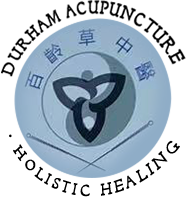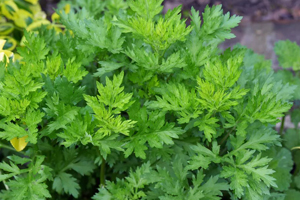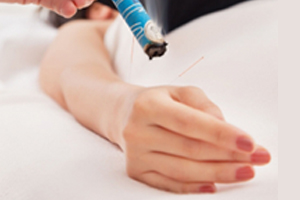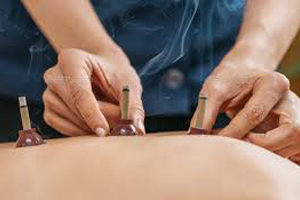Cupping & Moxibustion
Cupping
Cupping is a traditional Chinese medicine therapy dating back at least 2,000 years. Types of cupping include retained cupping, flash cupping, moving cupping, wet cupping, medicinal cupping, and needling cupping. Cupping is a type of alternative therapy that originated in China. It involves placing cups on the skin to create suction. The suction may facilitate healing with blood flow, when the blood flow freely to any part of the body, we do not have pain or get sick. Cupping has been used to treat a wide variety of conditions, it commonly used to treat physical pain, muscle tension, detoxification, build immune system. Cupping therapy combined with acupuncture and Chinese herb medicine it can treat digestive issues, skin problems, anxiety or depression, infertility, herpes Zoster(shingles), facial paralysis (Bell palsy), acne, and cervical spondylosis……
What happens during cupping and what can it treat?
We think that cupping works in much the same way as acupuncture by stimulating the blood flow in and around the meridians or acupoints to remove blockages that are preventing qi (vital life energy) from flowing smoothly around the body.
At our Clinic, we heat our thick glass cups by burning a wad of alcohol-soaked cotton wool inside. Once the cup is sufficiently warmed we take out the cotton and invert the cup over the desired area to be treated. The burning of the cotton wool removes all oxygen which creates a vacuum inside the cup so that when it is inverted and placed on the body it draws up the skin and flesh beneath as it cools.
The cup is left in place for 5-10 minutes, during which time it exerts a gentle pressure on the meridian, opens the pores, stimulates the blood’s circulation, breaks down obstructions, allows toxins to flow out of the acupoint and in this way realigns and balances the healthy flow of qi.
Cupping is generally used on the fleshier areas of the body such as the stomach, back, and occasionally legs and arms. The exact number of cups used and the amount of time they are left in place depends on the condition being treated.
We may also decide to apply herbal and/or medicated oils to the treatment area just before applying the cups. This allows us to slide the cups along the body keeping the vacuum intact but varying the amount of pressure that is exerted on the acupoints, which can further aid in breaking down and removing qi blockages.
Cupping is primarily used in China as a treatment for congestion, asthma, bronchitis and other respiratory disorders, some types of pain, and gastroenteritis and other abdominal conditions. It can also help to reduce swelling and alleviate depression.
At our Clinic, we heat our thick glass cups by burning a wad of alcohol-soaked cotton wool inside. Once the cup is sufficiently warmed we take out the cotton and invert the cup over the desired area to be treated. The burning of the cotton wool removes all oxygen which creates a vacuum inside the cup so that when it is inverted and placed on the body it draws up the skin and flesh beneath as it cools.
The cup is left in place for 5-10 minutes, during which time it exerts a gentle pressure on the meridian, opens the pores, stimulates the blood’s circulation, breaks down obstructions, allows toxins to flow out of the acupoint and in this way realigns and balances the healthy flow of qi.
Cupping is generally used on the fleshier areas of the body such as the stomach, back, and occasionally legs and arms. The exact number of cups used and the amount of time they are left in place depends on the condition being treated.
We may also decide to apply herbal and/or medicated oils to the treatment area just before applying the cups. This allows us to slide the cups along the body keeping the vacuum intact but varying the amount of pressure that is exerted on the acupoints, which can further aid in breaking down and removing qi blockages.
Cupping is primarily used in China as a treatment for congestion, asthma, bronchitis and other respiratory disorders, some types of pain, and gastroenteritis and other abdominal conditions. It can also help to reduce swelling and alleviate depression.
Are there other types of cupping?
The type of cupping described above is sometimes referred to as dry cupping, to distinguish it from wet or air cupping methods. In air cupping, the cup is inverted on the skin and a suction pump is attached to remove the air, which creates the vacuum. In wet cupping, acupuncture needles are first applied to the acupoints or meridians and then removed, after which the cup is applied to the skin and the vacuum formed either by the air or the dry method. With wet cupping, the small puncture hole made by the acupuncture needle will bleed slightly which Chinese Medicine Practitioners believe is helpful in removing toxins and other harmful substances from the bodies so that qi (vital energy) can flow smoothly and freely.
How safe is cupping? Will I feel any pain?
When practiced by an experienced traditional Chinese medicine specialist, cupping is extremely safe, particularly air cupping which involves neither heat nor needles. The only side effects may be some slight circular bruising and/or swelling afterwards which is caused by the drawing up of tiny blood vessels into the vacuum, but this quickly goes down within a day or so of treatment and is not usually painful. However, cupping is not suitable for every person and people who suffer from convulsions, inflamed skin or who have high fever or bleed easily should not undergo cupping. Pregnant women should avoid cupping on the lower back and stomach. In addition, an experienced practitioner will not usually move cups over bony parts of the body such as the shoulder blades or along spinal bumps.
Moxibustion
What is Moxibustion?
First, let’s talk about what moxibustion actually is.
Moxibustion in Traditional Chinese Medicine Moxibustion is an ancient technique that has been used for centuries in TCM. Your TCM practitioner will burn a cone or stick made of ground-up mugwort known as moxa. The smoldering moxa is placed near certain points on your body known as meridians (don’t worry, we’ll cover that in a little bit).
Moxibustion in Traditional Chinese Medicine Moxibustion is an ancient technique that has been used for centuries in TCM. Your TCM practitioner will burn a cone or stick made of ground-up mugwort known as moxa. The smoldering moxa is placed near certain points on your body known as meridians (don’t worry, we’ll cover that in a little bit).
What Is Moxa Made Of?
Moxa, Mugwort & Moxibustion in Traditional Chinese Medicine Moxa is made up of ground mugwort, an invasive weed species that is common in warm climates. Also known as Artemisia vulgaris or Ai Ye, mugwort takes its name from the moon goddess Athena because many folk medicine traditions use it to help with gynecological issues. In TCM in particular, mugwort is thought to help the Liver, Spleen and Kidney meridians by encouraging the flow of Qi and blood throughout the body. In TCM, heat in general has the ability to increase these flows, but mugwort combined with heat is an especially effective remedy. There are two main types of moxibustion treatments: indirect moxibustion and direct moxibustion. With direct moxibustion, the burning moxa is placed directly on your skin, but this is rarely done on Western clients. Your TCM practitioner will place the moxa directly on your skin, but remove it or extinguish it before it burns your skin. You shouldn’t feel any pain or discomfort–just a deep warmth. There are certain instances where a practitioner would let the moxa burn down until it extinguishes itself (scarring direct moxibustion) to cause blistering or scarring, but that is for specific cases and not likely what you’d start with! However, most people prefer indirect moxibustion. With indirect moxibustion, your TCM practitioner or acupuncturist will hold the lit moxa near (but not touching) yoru skin for a few minutes. They may also spread a layer or salt or garlic on your body as a layer between you and the moxa. You’ll feel the warming benefits of moxibustion without the risk of pain or scarring. Some people also like to combine moxibustion with acupuncture. Your acupuncturist will place the needle into your acupuncture point. Then, they will wrap the exposed end of the needle in moxa, delivering heat to the accupoint and surrounding area. Once you feel some relief, your acupuncturist will remove both the moxa and the needle.
Acupuncture Basics: Meridians
Before we go any further, let’s go over TCM beliefs about meridians. In TCM, the body has an energy network running throughout it. The pathways that connect different parts of the body are known as meridians. They provide a channel from the skin’s surface to internal organs which can be measured by released ATP, a cell-signaling molecule, to the acupoints along the meridian. Qi, the essential lifeforce in TCM, travels throughout these pathways, bringing energy and vitality throughout the body. In Western medicine, Chinese meridians are similar to fascial anatomy trains. When these pathways become clogged or closed, moxibustion can help open them back up so your Qi can flow freely once again!
The Benefits of Moxibustion
What Does Moxibustion Do?
Moxa, Mugwort & Moxibustion in Traditional Chinese Medicine SteamKnow that we know exactly what moxibustion is and how it works, let’s get to the point. Why do people do moxibustion? In TCM, moxibustion is used to help warm up people’s bodies in order to increase the vital flow of Qi. By combining heat and the powerful herb of mugwort, moxibustion helps to expel any coldness in the body that might be clogging up your meridians. The heat stimulates your acupuncture points and encourages Qi to travel through your body’s pathways. In TCM, low Qi circulation can cause quite a few problems. First of all, it disrupts the careful balance of Qi that is crucial to maintaining your health and defending your body and mind against disease. Second, since QI moves blood, it can impair circulation. This can cause you to be depressed, fatigued, or excessively sweaty. Even if you don’t have any of these symptoms and signs of poor Qi circulation, it’s a good idea to try moxibustion anyway. Keeping your meridians clear and open is key to maintaining both your physical and mental health. Good Qi flow strengthens your immune system and organs. Plus, if you have pain related to coldness (like arthritis), moxibustion can provide relief.
What Does Moxibustion Help With?
Poor Qi flow can cause lots of problems. Here are a few that practitioners use moxibustion for: Gastrointestinal and digestive issues like diarrhea, colitis, irritable bowel syndrome, and constipation Menstrual cramps
Nausea caused by Chemotherapy
Asthma
Eczema
Fatigue It’s important to remember that while moxibustion has been used to treat these and other health issues for centuries, few western studies have been conducted to support TCM claims.
Nausea caused by Chemotherapy
Asthma
Eczema
Fatigue It’s important to remember that while moxibustion has been used to treat these and other health issues for centuries, few western studies have been conducted to support TCM claims.
What Are Some Other Benefits of Moxibustion?
Moxa, Mugwort & Moxibustion in Traditional Chinese Medicine Don’t have any of the issues listed above but still want to try moxibustion? Here are a few other things this TCM practice can help with:
Warming the body: In TCM, our bodies work to maintain a delicate balance–something like what we call homeostasis in the West. The food we eat is either cold, cool, neutral, warm or hot and can affect the temperature balance in our body. But diseases and health issues can also throw off this balance. If you have too much coldness in your body, you may suffer from autoimmune diseases, low immunity or a blood condition. Moxibustion brings back heat to the body which can rebalance your temperature and relieve you of these issues. Aches and pains: Because moxibustion is warming, it can help relieve aches and pains related to excess coldness. Moxibustion heats up the meridians which increases both the flow of Qi and blood throughout the body. Increased blood flow can bring nutrients and energy to different muscles and organs to ease soreness and pain. Better immunity: In studies conducted on mice, moxibustion raised white blood cell counts, leading researchers to believe it can do the same in humans. If you have a low white blood cell count, your immune system may be weakened. Moxibustion can help by boosting white cells and improving your immune system. Easing inflammation: By improving blood flow, moxibustion can ease inflammation. Whether you’re dealing with sore muscles, inflammation from illness, or chronic arthritis, moxibustion can reduce the swelling and discomfort.
Who Shouldn’t Try Moxibustion?
Moxibustion has many practical and helpful uses, and has been practiced safely in TCM for centuries. However, it’s not recommended for everyone.
Because moxibustion can add heat to the body, it is ideal for people who are too cold, but not good for those diagnosed with excess heat unless the practitioner uses techniques to bring. Heat to the surface and to vent it, Also, due to the burning of mugwort, moxibustion can be uncomfortable for people with respiratory problems due to the smoke. Although there are smokeless moxa sticks available, they tend not to warm as well, but you can ask your TCM practitioner about them. In China, Vietnam and Japan, moxa is mixed with other herbs like chuanxiong to add specific effects. Moxibustion is a great way to maintain your health and vitality. Just make sure you work with an experienced TCM practitioner or acupuncturist to get the most out of your moxibustion experience!








